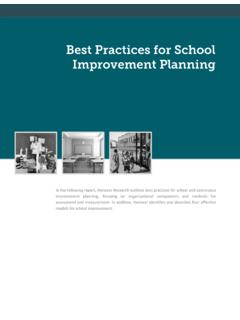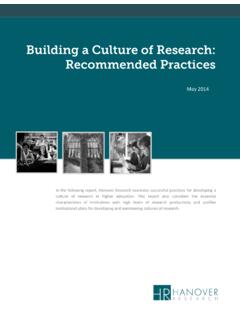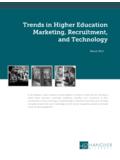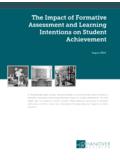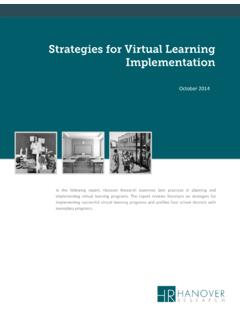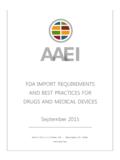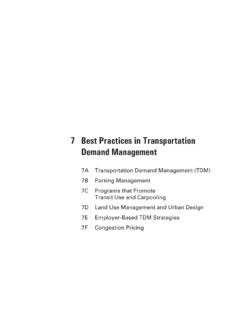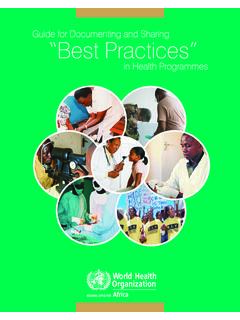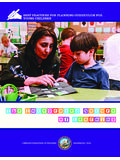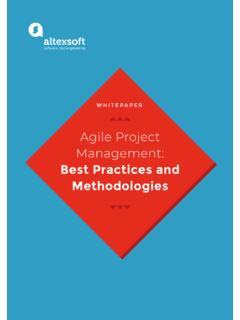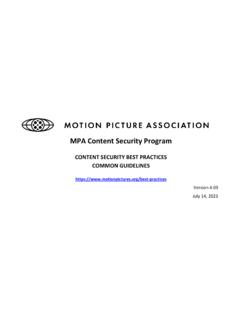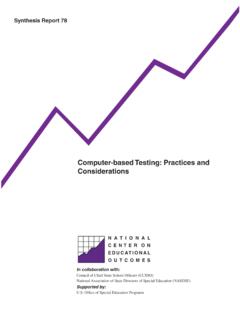Transcription of Best Practices in K-12 Literacy Models - Hanover Research
1 In the following report, Hanover Research examines the need for effective reading and Literacy education, along with the role of assessment in Literacy instruction. In addition, the report reviews four Models designed to promote Literacy education for all students. best Practices in K-12 Literacy Models November 2014 Hanover Research | November 2014 2014 Hanover Research | District Administration Practice 2 TABLE OF CONTENTS Executive Summary and Key Findings .. 3 INTRODUCTION .. 3 KEY FINDINGS .. 3 Section I: Measuring Reading Ability and Improving Reading in the Early Grades .. 5 IMPORTANCE OF ELEMENTARY LEVEL READING .. 5 APPROACHES TO MEASURING STUDENT READING ABILITY AND READING LEVEL .. 6 Essential Components of Reading.
2 6 Grade Level Expectations .. 8 Developmental Scales: The Lexile Framework for Reading .. 10 STRATEGIES FOR IMPROVING READING IN THE EARLY GRADES .. 10 District Level Strategies .. 10 School Level Strategies .. 12 Classroom Strategies .. 13 Reading Assessments .. 14 Section II: Strategies for Assessing Grade Level 15 TYPES OF ASSESSMENTS .. 15 Formative and Summative Assessments .. 16 Considerations for Assessment Selection .. 16 WIDELY USED ASSESSMENTS .. 18 Phonological Awareness Literacy Screening (PALS) .. 19 Development Reading Assessment (DRA) .. 20 The Lexile Framework .. 22 Section III: Literacy Models .. 24 OREGON DEPARTMENT OF EDUCATION COMPREHENSIVE K 12 Literacy model .. 24 PARTNERSHIP IN COMPREHENSIVE Literacy & COMPREHENSIVE INTERVENTION model .
3 26 THE Literacy COLLABORATIVE .. 29 THE Literacy DESIGN COLLABORATIVE .. 31 Hanover Research | November 2014 2014 Hanover Research | District Administration Practice 3 EXECUTIVE SUMMARY AND KEY FINDINGS INTRODUCTION For decades, educators have sought effective strategies to improve student reading skills, and have debated the topic fiercely through what the National Education Association refers to as the reading wars. 1 While the educational community has yet to identify one best solution, knowledge of how students learn to read has grown substantially in recent years. Today, a nationwide focus on assessment has promised to improve the understanding of student learning and inform instructional decisions for each individual student.
4 This report provides an overview of effective strategies for improving reading instruction and assessment, with a focus on comprehensive Literacy Models aimed at fostering Literacy for all students. The report is divided into three sections: Section I discusses the need for effective reading and Literacy education, particularly in the elementary years. In addition, this section discusses the role of leadership in implementing effective Literacy Models . Section II examines primary forms of reading ability assessment and assessment tools. This section also profiles widely used assessment tools. Section III profiles four comprehensive, Research supported Models for organizing Literacy instruction. KEY FINDINGS Researchers and educators have not established universal or standardized measures of reading ability for specific grade levels.
5 The most widely used standardized measure of student reading ability, The Lexile Framework, does not report scores according to grade level specific measurements. However, some states, like Washington State, outline their own expectations for reading ability at specific grade levels, and tailor assessment activities to support those expectations. Researchers have identified five key components that are essential to success for students learning to read. These components include comprehension, vocabulary, fluency, phonemic awareness, and phonics. Assessments that measure these components can indicate student progress in reading and identify those students who are at risk of falling behind. Research reveals several common key elements of successful Literacy Models .
6 These are not all student specific or classroom behaviors. To maximize the likelihood of success, reading programs should be comprehensive and engage the school as well as parents and the community. Common elements of effective Models incorporate: 1. An emphasis on professional development. 1 Reading Wars. National Education Association. Hanover Research | November 2014 2014 Hanover Research | District Administration Practice 4 2. Individualized learning through one to one or small group exercises. 3. Differentiated learning for different learning needs. 4. Regular data collection to provide accurate assessments of success and to inform instruction. 5. Well defined goals and benchmarks, with specific strategies for implementation.
7 Effective district and school level leadership is required for the implementation of new programs, and reading initiatives are no different. In addition to ensuring teachers receive sufficient professional development, principals and administrators should collect and analyze data to monitor student progress, give teachers adequate time and resources to support student learning, and provide oversight and management for interventions. Leaders must implement district , school , and classroom level strategies to substantially improve reading skill development. The issues facing struggling readers are diverse and complex, and may require leaders to adopt strategies that directly address the quality and effectiveness of instruction, assessment, curriculum, resource allocation, and school climate.
8 Leaders in Literacy education overwhelmingly agree that any substantive improvement in student reading skills will require significant professional development across all levels of a given district. Learning gaps emerge early. Studies demonstrate that, if reading deficiencies are recognized in grade 1, students can catch up to grade level by the end of grade 2. The same ability to catch up is not identified in later grades, as grade level expectations become more difficult, and students fall further behind. Unfortunately, most schools do not identify reading skill deficits until grades 2 or 3. Hanover Research | November 2014 2014 Hanover Research | District Administration Practice 5 SECTION I: MEASURING READING ABILITY AND IMPROVING READING IN THE EARLY GRADES The ability to read is an essential building block for a child s educational success.
9 Over the past decade, Research has underscored the importance of early Literacy education, suggesting that students who do not learn to read proficiently by the end of grade 3 may never reach grade level Literacy Furthermore, studies show that students with poor Literacy skills persisting into adolescence and adulthood are more likely to experience negative social outcomes, such as delinquency or social In this section of the report, Hanover Research examines the importance of early reading, measures of student reading ability by grade level, and strategies for improving early reading. IMPORTANCE OF ELEMENTARY LEVEL READING Results from the National Assessment of Educational Progress (NAEP) exam reveal that, in 2011, 33 percent of grade 4 students in the United States failed to achieve basic levels of reading achievement.
10 This incidence rate was even higher among low income students, ethnic minority groups, and students learning English as a second Among grade 8 students, a national average of 24 percent of students did not achieve basic proficiency in reading on the NAEP The elementary school years build a critical foundation for children s later learning. The idea that learning gaps emerge early in children s lives is one of the better documented facts in education. 6 Research demonstrates that students early learning experiences impacts their future learning across all subjects, not only reading. Students learn concepts in elementary school that are built on in later years, and, without a successful foundation of appropriate skills and abilities, students may struggle in the upper grades.
